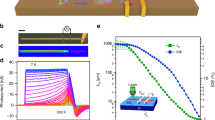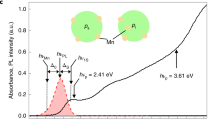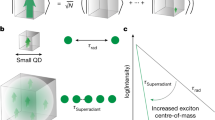Abstract
Bound states of electron–hole pairs (excitons) in semiconductors possess desirable properties — such as an enhanced oscillator strength for radiative recombination — that hold promise for the next generation of optical devices. However, at typical device operating conditions (room temperature and moderate charge densities), excitons dissociate to form an electron–hole plasma. Dissociation may be prevented by confining excitons to lower dimensions, where their binding energy is expected to increase significantly1. But such confinement may in turn influence the dynamical properties of the excitons. Here we report spatially resolved photoluminescence images of excitons confined to an isolated gallium arsenide quantum wire. As the temperature of the structure is lowered, we observe a striking transition from broad and fairly continuous photoluminescence to an intense set of emission peaks which are both energetically sharp and spatially localized. Such behaviour indicates that, at sufficiently low temperatures, the quantum wire acts like a sparse set of quantum dots. Furthermore, at the site of an isolated quantum dot, we observe an unusual decrease in the relaxation rate of excitons, such that they radiate (via recombination) from higher energy states before relaxing to their ground state. We argue that this is the manifestation of an exciton relaxation ‘bottleneck’, the existence of which could pose problems for the development of optical devices based on quantum dots.
This is a preview of subscription content, access via your institution
Access options
Subscribe to this journal
Receive 51 print issues and online access
$199.00 per year
only $3.90 per issue
Buy this article
- Purchase on Springer Link
- Instant access to full article PDF
Prices may be subject to local taxes which are calculated during checkout





Similar content being viewed by others
References
Loudon, R. One-dimensional hydrogen atom. Am. J. Phys. 27, 649–655 (1959).
Chang, Y.-C., Chang, L. L. & Esaki, L. Anew one-dimensional quantum well structure. Appl. Phys. Lett. 47, 1324–1326 (1985).
Pfeiffer, L. N. et al. Formation of a high quality two-dimensional electron gas on cleaved GaAs. Appl. Phys. Lett. 56, 1697–1699 (1990).
Wegscheider, W. et al. Lasing from excitons in quautum wires. Phys. Rev. Lett. 71, 4071–4074 (1993).
Wegscheider, W., Pfeiffer, L. N., West, K. W. & Leibenguth, R. E. Current injection GaAs/AlGaAs quantum wire lasers fabricated by cleaved edge overgrowth. Appl. Phys. Lett. 65, 2510–2512 (1994).
Goñi, A. R. et al. Observation of quantum wire formation at intersecting quantum wells. Appl. Phys. Lett. 61, 1956–1958 (1992).
Someya, T., Akiyama, H. & Sakaki, H. Tightly confined one-dimensional states in T-shaped GaAs edge quantum wires with AlAs barriers. Appl. Phys. Lett. 66, 3672–3673 (1995).
Hasen, J. et al. Large excitonic confinement in asymmetric quantum T wires. Superlattices and Microsctructures (in the press).
Gislason, H., Langbein, W. & Hvam, J. M. Asymmetric GaAs/AlGaAs T wires with large confinement energies. Appl. Phys. Lett. 69, 3248–3250 (1996).
Hess, H. F., Betzig, E., Harris, T. D., Pfeiffer, L. N. & West, K. W. Near-field spectroscopy of the quantum constituents of a luminescent system. Science 264, 1740–1745 (1994).
Zrenner, A. et al. Quantum dots formed by interface fluctuations in AlAs/GaAs coupled quantum well structures. Phys. Rev. Lett. 72, 3382–3385 (1994).
Brunner, K., Abstreiter, G., Böhm, G., Tränkle, G. & Weimann, G. Sharp-line photoluminescence of excitons localized at GaAs/AlGaAs quantum well inhomogeneities. Appl. Phys. Lett. 64, 3320–3322 (1994).
Gammon, D., Snow, E. S., Shanabrook, B. V., Katzer, D. S. & Park, D. Fine structure splitting in the optical spectra of single GaAs quantum dots. Phys. Rev. Lett. 76, 3005–3008 (1996).
Benisty, H., Sotomayor-Torrès, C. M. & Weisbuch, C. Intrinsic mechanism for the poor luminescence properties of quantum-box systems. Phys. Rev. B 44, 10945–10948 (1991).
Acknowledgements
We thank H. U. Baranger, T. D. Harris, P. B. Littlewood and R. Zimmermann for discussions.
Author information
Authors and Affiliations
Corresponding author
Rights and permissions
About this article
Cite this article
Hasen, J., Pfeiffer, L., Pinczuk, A. et al. Metamorphosis of a quantum wire into quantum dots. Nature 390, 54–57 (1997). https://doi.org/10.1038/36299
Received:
Accepted:
Issue Date:
DOI: https://doi.org/10.1038/36299
This article is cited by
-
Two- versus three-dimensional quantum confinement in indium phosphide wires and dots
Nature Materials (2003)
Comments
By submitting a comment you agree to abide by our Terms and Community Guidelines. If you find something abusive or that does not comply with our terms or guidelines please flag it as inappropriate.



